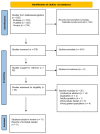Comparative Efficacy and Safety of Glucagon-like Peptide-1 Receptor Agonists in Children and Adolescents with Obesity or Overweight: A Systematic Review and Network Meta-Analysis
- PMID: 39065679
- PMCID: PMC11279917
- DOI: 10.3390/ph17070828
Comparative Efficacy and Safety of Glucagon-like Peptide-1 Receptor Agonists in Children and Adolescents with Obesity or Overweight: A Systematic Review and Network Meta-Analysis
Abstract
Four glucagon-like peptide-1 receptor agonists (GLP-1 RAs) have been used in children and adolescents with obesity or overweight. This network meta-analysis was conducted to compare the efficacy and safety of these regimens. Embase, PubMed, and Scopus were searched on March 2023 and updated in June 2024 for eligible randomized controlled trials (RCTs). The primary efficacy outcomes were mean difference in actual body weight, BMI (body mass index), BMI z score, and waist circumference. Safety outcomes included nausea, vomiting, diarrhea, abdominal pain, injection-site reaction, and hypoglycemia. Eleven RCTs with 953 participants were eligible. Semaglutide exhibited greater effects in reducing weight, BMI, and BMI z score versus the placebo. Semaglutide was associated with greater weight loss and BMI z score reduction in comparison with exenatide, liraglutide, and dulaglutide. Semaglutide also significantly decreased BMI than exenatide. None of the four GLP-1 RAs were associated with higher risks of diarrhea, headache, and abdominal pain versus the placebo. Liraglutide was more likely to cause nausea, vomiting, hypoglycemia, and injection-site reactions than the placebo. Liraglutide also had higher odds of causing injection-site reactions than other GLP-1 RAs. Semaglutide appeared to be the most effective and safe option among four GLP-1 RAs in children and adolescents with obesity or overweight.
Keywords: GLP-1RAs; adolescents; efficacy; network meta-analysis; obesity; safety; semaglutide.
Conflict of interest statement
The authors declare no conflicts of interest.
Figures


 . Abbreviations: BMI, body mass index; HbA1c, hemoglobin A1C; DBP, diastolic blood pressure; SBP, systolic blood pressure; FPG, fasting plasma glucose; QOL, quality of life.
. Abbreviations: BMI, body mass index; HbA1c, hemoglobin A1C; DBP, diastolic blood pressure; SBP, systolic blood pressure; FPG, fasting plasma glucose; QOL, quality of life.
References
Publication types
LinkOut - more resources
Full Text Sources

